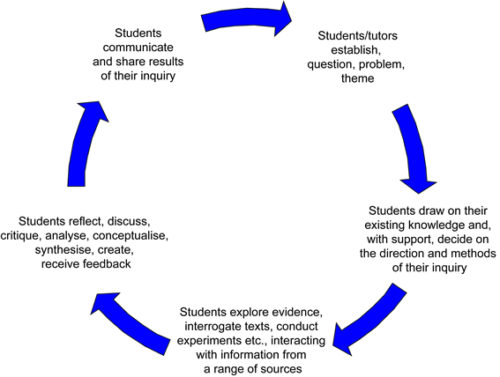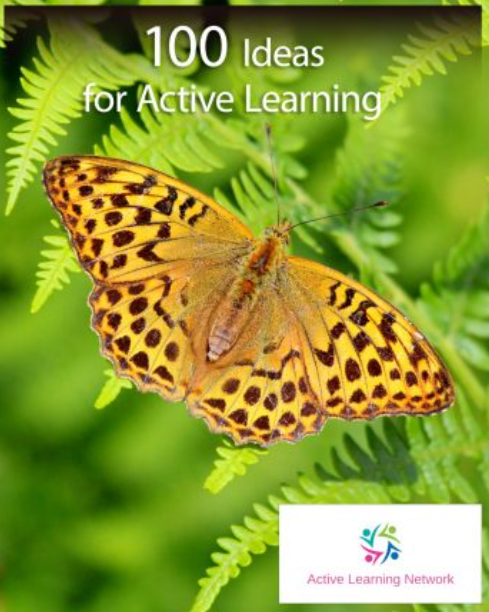Home » Administration » Academic Affairs and Registrar » UDL » Applying UDL » Instructional Strategies
Instructional Strategies
Active learning is a blanket term for any learning activity that requires students to become active participants, rather than passive observers.
Active learning requires students to take more ownership of their learning and drive lessons through collaboration, inquiry, and participation. To do this, students must be seen as partners in building knowledge.
An emphasis on active learning does not mean that lectures should no longer take place. Rather, active learning strategies can be built in and dispersed throughout lessons to compliment lectures.
Even though active learning may simply feel like fun, it is rigorous and backed by research, and learning outcomes prove it. This is especially true for underrepresented student groups. Plus, students really enjoy it. There are myriad ways of including active strategies into your lessons. Check out some of this resource for simple ideas you can implement right away: 52 Activities for Student Engagement
Here is an example of active learning in practice in a large lecture hall:
A significant hurdle for teachers to overcome when approaching student-lead learning is shifting from an instructor mindset to a facilitator mindset. An instructor mindset holds that the teacher imparts knowledge and that knowledge is fixed. A facilitator understands that the process of learning is dynamic and reciprocal. To do this, students must feel safe, valued, and prepared. Expecting students to engage in the messy process of inquiry without establishing a classroom culture to support it is imprudent. Therefore, a focus on explicitly teaching and nurturing social and emotional skills is paramount.
This FREE E-book is full of great ideas and theoretical grounding for active learning:
Learning analytics (LA) can be utilized for a variety of purposes such as identifying barriers, providing specific feedback, and identifying students who may be struggling.
You do not need a computer science degree to do it, either. Use this guide from CAST to learn about easy ways to use the data that is all around us. You can also take a look at a project happening at ATU Galway – Mayo, below.
For moodle, use this helpful guide from Dundalk University.
Please be mindful of GDPR when using LA.
For more information, consult the Online Resources for Learning Analytics (ORLA) resource page on the Forum for Teaching and Learning website.
Harnessing Student Engagement Data for Personalised Feedback
Research shows that students perform better, feel happier, and learn more when they feel that they are part of an inclusive learning community (Elmi, 2020; Immodino-Yang, M. H., 2016). In a 2022 student survey asking what makes a good instructor, students overwhelmingly pointed to instructors that fostered a sense of belonging. Building community can feel overwhelming with large class sizes and not having enough time. However, adding small changes can have very large impacts on student learning. Ice breakers, group games, or fun routines to your classes should take up less than 5 minutes of class time, and in doing so, you will have happier students who attend class more frequently.
Another way to build community is about sharing about yourself, adding democratic decision making to class, and developing group norms collaboratively with students. Another tip is to consider adding an inclusivity statement to your syllabus. This can be something as simple as, “I am committed to creating a welcoming, inclusive, and accessible course. I am here to help you learn, so please feel free to contact me [here] with any questions or concerns.” Also, include links to student services offices such as counselling and health services on your moodle page. These small gestures will demonstrate that student voices are valuable.
Explicitly teach the “hidden curriculum.” This refers to the unwritten rules and assumptions of university life which students are expected to conform to. These rules are not necessarily evident in the formal curriculum and are not known by all students. The hidden curriculum can be taught by being transparent in your expectations of students and outlining what their options are (especially with assessments). This is especially important for first-generation or non-traditional students.
Culturally responsive teaching is also a critical component of building community. This involves taking into account the language, customs, perspectives and experiences of all students and incorporating this into your curriculum and classroom practices. The aim is for all students to feel represented within the classroom and that the curriculum is relevant to them. The UDL guidelines can help facilitate this by encouraging student voice and participation, valuing students as co-creators of knowledge, and providing flexibility in how students demonstrate their understanding. UDL and culturally responsive teaching both recognize that the variability of learners is asset in a classroom and should be leveraged to contribute to broader and more nuanced learning for all.
The implementation of a flipped classroom model in a university course has proven to be a highly effective and engaging teaching approach. In this innovative approach, the traditional roles of in-class lectures and homework assignments are reversed. Students are provided with pre-recorded lectures or reading materials to review independently before attending class, allowing them to acquire foundational knowledge at their own pace. During class time, instructors focus on facilitating interactive discussions, group activities, and problem-solving exercises that promote deeper understanding and critical thinking.
This model encourages active student participation, collaboration, and the application of concepts in real-world scenarios. By shifting the traditional lecture-based format, the flipped classroom model enhances student engagement, fosters a more personalized learning experience, and empowers students to take ownership of their education. It also offers instructors the opportunity to provide individualized support and guidance, catering to the unique needs of each student. Overall, the flipped classroom model represents a progressive approach to education that enhances student learning outcomes and prepares them for the challenges of the 21st century.
Learn more about how this can be applied in your own practice from this article in the AHEAD Journal.
- Explore digital tools on our DigitalEd website
- Teams Class Notebook for collaboration
- Padlet for peer collaboration and sharing
- Pebblepad for student portfolios
- Microsoft Forms for exit tickets or in-class formative assessment
- Vevox for interactive creating polls within presentations.
Another important aspect of providing multiple means of representation is ensuring that students have a clear understanding of the goals, objectives, and design of the course. A key to this is imagining yourself as a beginner again, rather than the expert that you are. Below are some ideas that might help:
- Provide a detailed syllabus with a calendar and stick to it.
- Activate prior knowledge through relevant examples, stories, and metaphors.
- Discuss the learning objectives of the course as a whole and for each class meeting early and often. Explain it in multiple ways, write it down where everyone can see it, and describe it in context. All students should be able to articulate exactly what they are supposed to be learning and why.
- Separate the means of a learning objective from the ends. This breaks down individual skills from the broader mastery of a subject. This is motivating for students because it makes learning objectives seem more attainable. It also allows for flexibility on how these skills are demonstrated.
- Share your notes and presentation slides before each class. Also, consider sharing videos or recordings of lectures – this has been shown to enhance student learning and reduce anxiety.
- You could also ask students to co-create and share notes with each other.
- Provide a glossary of subject-specific vocabulary (or have students co-create this).
- Make guided notes and graphic organizers.
Student-lead learning based around inquiry and problem solving is widely seen as an effective method for increasing engagement and sense of empowerment while promoting relevancy and authenticity. Inquiry-based learning allows students to choose their own methods for solving problems and in doing so helps build understanding. This method helps students learn not simply what is important, but why it makes sense and is worth learning. IBL is supported by contructivist educational theory as students will naturally apply their own prior knowledge to a problem and thus make lasting connection to concepts in an authentic way. Studies have shown that what students learn through this process is more meaningful and lasting.
This process often requires students to work cooperatively to evaluate and make meaning of their evidence. Students are encouraged to experiment and make mistakes while understanding that there may not be one single correct answer. This process also amplifies their position in the learning process and empowers students as co-creators of knowledge.
Finally, Inquiry-based learning has been shown to be equity-focused as it motivates and engages learners who are low-achieving or come from less privileged backgrounds by allowing multiple entry points and perspectives to engage in learning. It allows different perspectives to be considered and proves that this is a valuable asset.

From Levy, et al., 2011 and accessed from https://www.qub.ac.uk/directorates/AcademicStudentAffairs/CentreforEducationalDevelopment/UsefulInformation/Linkingresearchandteaching/Inquiry-basedlearningIBL/
